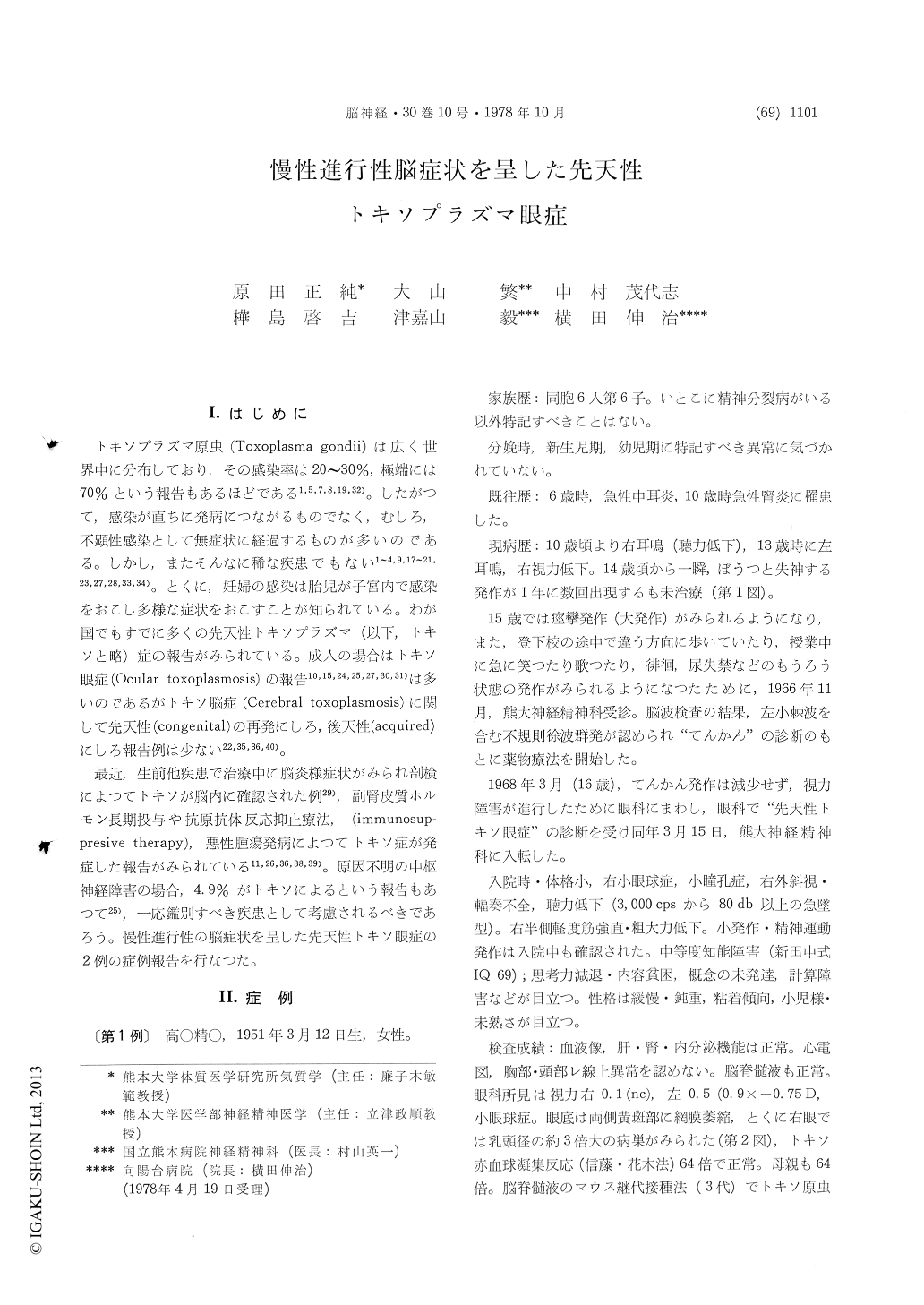Japanese
English
- 有料閲覧
- Abstract 文献概要
- 1ページ目 Look Inside
I.はじめに
トキソプラズマ原虫(Toxoplasma gondii)は広く世界中に分布しており,その感染率は20〜30%,極端には70%という報告もあるほどである1,5,7,8,19,32)。したがつて,感染が直ちに発病につながるものでなく,むしろ,不顕性感染として無症状に経過するものが多いのである。しかし,またそんなに稀な疾患でもない1〜4,9,17〜21,23,27,28,33,34)。とくに,妊婦の感染は胎児が子宮内で感染をおこし多様な症状をおこすことが知られている。わが国でもすでに多くの先天性トキソプラズマ(以下,トキソと略)症の報告がみられている。成人の場合はトキソ眼症(Ocular toxoplasmosis)の報告10,5,24,25,27,30,31)は多いのであるがトキソ脳症(Cerebral toxoplasmosis)に関して先天性(congenital)の再発にしろ,後天性(acquired)にしろ報告例は少ない22,35,36,40)。
最近,生前他疾患で治療中に脳炎様症状がみられ剖検によつてトキソが脳内に確認された例29),副腎皮質ホルモン長期投与や抗原抗体反応抑止療法,(immunosup—presive therapy),悪性腫瘍発病によつてトキソ症が発症した報告がみられている11,26,36,38,39)。原因不明の中枢神経障害の場合,4.9%がトキソによるという報告もあつて25),一応鑑別すべき疾患として考慮されるべきであろう。慢性進行性の脳症状を呈した先天性トキソ眼症の2例の症例報告を行なつた。
The neurological manifestations in two cases of congenital ocular toxoplasmosis are reported.
The first patient, a 27-year-old female, had ex-perienced visual disturbance at the onset of the illness, when she was 13 years old. The history of her mental and physical development had been considered normal. One year later, she suffered various epileptic symptoms such as petit mal, general convulsion and psychomotor seizure. She was admitted to Kumamoto University Hospital in March 1968, when she was 16 years old, with epilepsy and visual disturbance. Neurological ex-amination revealed muscular weakness, rigidity, strabismus, slight dysarthria and disturbance of intelligence. The electroencephalogram showed irregular spike and wave complex. Results of a lumbar puncture, roentgenography examination of the skull and hematochemical examinations werenormal.
Ophthalomological symptoms of typical congenital ocular toxoplasmosis, such as focal chorioretinal atrophy, microcoria and optic nerve atrophy, were found in the fundi. However, a hemagglutination test of toxoplasma was within normal in a titer of 1: 64. The patient was treated with anticonvulsant drugs and spiromycin. Thereafter, epileptic seizure were relieved, but, gradually she developed marked character changes and dementia.
In 1975, when the patient was 24 years old, epileptic seizures increased again. At last, in 1977, she showed epileptic psychosis and spent two years in a mental hospital.
The second patient, a 39-year-old male, experi-enced slight visual disturbance when he was 10 years old. His grandmother also had experienced visual disturbance and became blind. His history of mental and physical development had been considered normal until he showed poor performance at primary school. Ten years later, visual dis-turbance, dysarthria and weakness appeared. When he was 26 years old an epileptic attack occurred. The patient was admitted to Kumamoto University Hospital in Febrary 1968, when he was 29 years old. Clinical symptoms were dysarthria, ataxia, weakness, hyperreflexia, tremor, mental retardation and unconsciousness fits, and these progressed gradually. The electroencephalogram showed diffuse, irregular, slow activity. The spinal fluid and hemato-chemical tests were normal. An ex-amination of the fundi showed a typical congenital ocular toxoplasmosis. Also, cerebral calcifications were found in roentgenography of the skull. Also, the hemagglutination test was positive in a titer of 1: 256. These symptoms were unrelieved and gradually progressed. In 1978, a computed tomo-graphy showed diffuse cerebral atrophy.
The manifestations of fully developed congenital toxoplasmosis are those of hydrocephalus, mental retardation, epilepsy, cerebral calcification and chorioretinitis. These two cases are considered imcomplete congenital toxoplasmosis excepting the ocular symptoms. It worthy of note that symptoms of the central nervous symptom developed gradually from childhood up to the age of 30 or 40. These cases may be called late-developing exacerbations of congenital toxoplasmosis.

Copyright © 1978, Igaku-Shoin Ltd. All rights reserved.


